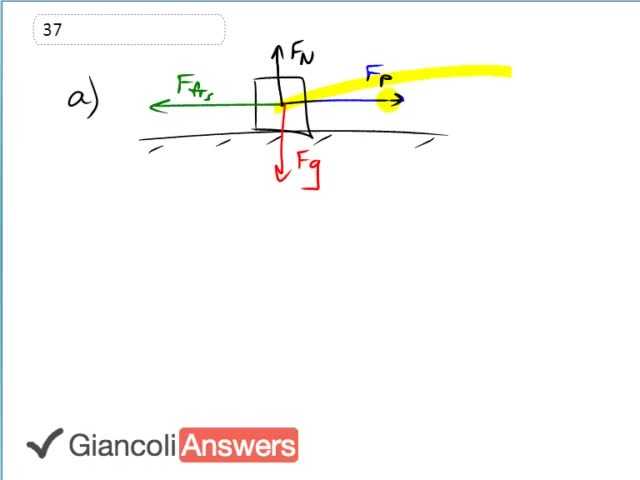
b)

In order to watch this solution you need to have a subscription.
When the box just starts to move the picture looks like this with the force that’s pulling it along equaling the static friction force and we also have gravity and normal force which are equal in this case. So we can say that the normal force equals ‘mg’ because that’s what gravity is and then we know that the static friction force equals the coefficient of static friction times ‘Fn’ and that has to equal ‘Fp’ at this moment where it just begins to move. And then we can substitute for ‘mg’ in place of ‘Fn’ and say that the pulling force is equal to ‘µs’ times ‘mg’ and then we’ll solve for the coefficient of static friction by dividing both sides by ‘mg’. So we have ‘µs’ is ‘Fp’ over ‘mg’ which is forty eight point zero newtons divided by five point zero kilograms times nine point eight newtons per kilogram which is zero point nine seven nine six which in two significant figures is zero point nine eight. It has no units because it’s a force divided by a force so the units cancel In part b we’re told that the force that was originally pulling it along is staying constant and friction however will decrease because it turns into kinetic friction now that it’s sliding and so the box will accelerate. The arrow to the right is longer than the arrow to the left so it’s kinetic friction now. Here’s our free body diagram. We can say that the force to the right minus the force to the left, pulling to the right friction to the left, equals the mass times acceleration, that’s Newton’s second law. And we’ll substitute for the friction force and say that it’s ‘µk’ times ‘mg’, ‘mg’ being the normal force which is equal to gravity, and then we’ll simplify and then solve for ‘µk’. Dividing here by ‘mg’ to solve for the coefficient of kinetic friction: ‘Fp’ minus ‘ma’ divided by ‘mg’, that’s forty eight point zero newtons minus five point zero kilograms time zero point seven zero meters per second squared divided by five kilograms times nine point eight meters per second squared and this gives zero point nine one. In the 5th Edition it’s forty newtons so your calculation will actually work out to zero point eight two. So zero point eight two is the 5th Edition answer. And for coefficient of kinetic friction zero point seven four is what you get in this calculation using forty newtons which is the fifth edition number.
Thank you very much amorderayray for noticing that typo in the video. Yes, 48N should be written instead of 40N... the answers come out correctly since I used 48N in my calculations, but I've added this video to my revision list. Thanks again and all the best with your studies.
It should be 48N divided by (5)(9.8). I was thrown off at first.
This video has been updated.
Dear Mr.Dychko thank you so much for your help :)
Best regards ,
Yana
You're welcome! =)
At 3:40 I think it jumps back to A while talking about B. or skips a step
Hi dsgarrido17, I can see what you mean since the video suddenly has a different sound and brightness at that point. It's the result of correcting a typo in the video where I stitched two different 'takes' together. It's still talking about part (a) at 3:40.
Cheers,
Mr. Dychko